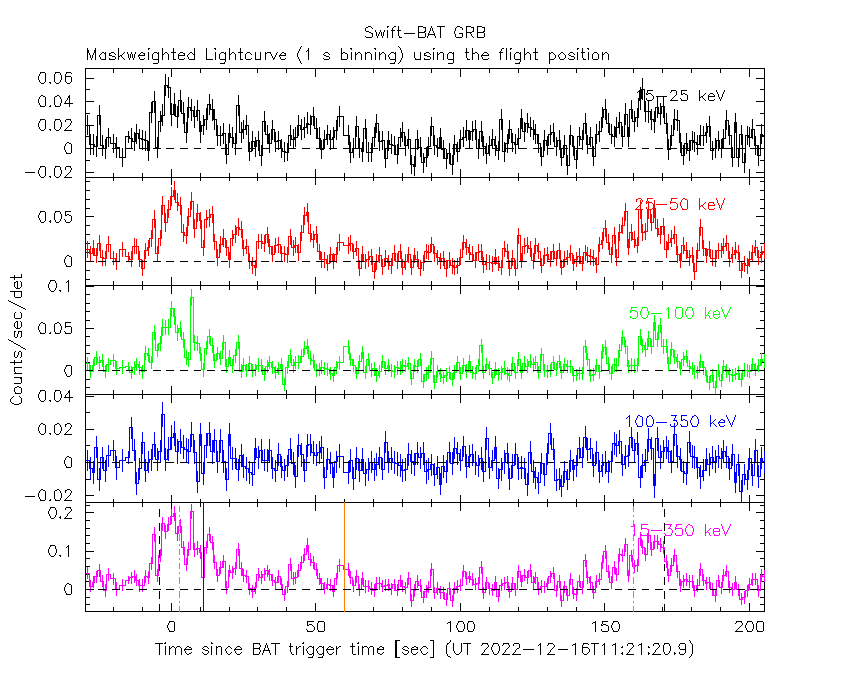
S. Dichiara (PSU), E. Ambrosi (INAF-IASFPA) and P. Kuin (MSSL/UCL) for the Swift team
At 11:21:20 UT, the Swift Burst Alert Telescope (BAT) triggered and located GRB 221216A (trigger=1144698) (Dichiara et al. GCN Circ. 33067). Swift slewed immediately to the burst. At the time of the trigger, the initial BAT position was 55° from the Sun (4.2 hours East) and 139° from the 49%-illuminated Moon. Table 1 contains the best reported positions from Swift, and the latest XRT position can be viewed at http://www.swift.ac.uk/xrt_positions.
Table 2 is a summary of GCN Circulars about this GRB from observatories other than Swift.
Standard analysis products for this burst are available at https://gcn.gsfc.nasa.gov/swift_gnd_ana.html.
As reported by Krimm et al. (GCN Circ. 33254),
the BAT ground-calculated position is
RA, Dec = 326.023, -34.394 deg which is
RA(J2000) = 2
The mask-weighted light curve (Figure 1) shows two broad peaks, one centered around T+0,
and the other at T+165 seconds.
There is a third, more narrow and weaker peak
at T+50 seconds and some possible subsidiary peaks.
Note that not all of the event
data is available, so it is possible that the burst extended before or after this period.
The time-averaged spectrum from -9.68 to T+175.22 s is best fit by a power law
with an exponential cutoff.
This fit gives a photon index 1.02 ± 0.36,
and
The results of the batgrbproduct analysis are available at https://gcn.gsfc.nasa.gov/notices_s/1144698/BA/.
Analysis of the initial XRT data was reported by Ambrosi et al. (GCN Circ. 33076). We have analysed 23 ks of XRT data for GRB 221216A, from 61 s to 382.3 ks after the BAT trigger. The data comprise 263 s in Windowed Timing (WT) mode (the first 10 s were taken while Swift was slewing) with the remainder in Photon Counting (PC) mode. The enhanced XRT position for this burst was given by Evans et al. (GCN Circ. 33071).
The late-time light curve (Figure 2) (from T0+4.6 ks) can be modelled with an initial power-law decay with an index of α=0.30 (+0.16, -0.17), followed by a break at T+12.8 ks to an α of 2.42 (+0.21, -0.19).
A spectrum formed from the WT mode data can be fitted with an absorbed power-law with a photon spectral index of 1.58 ± 0.03. The best-fitting absorption column is 1.49 (+0.13, -0.12) x 1
A summary of the PC-mode spectrum is thus:
Total column: 4.3 (+2.8, -1.5) x 1
Galactic foreground: 2.8 x 1
Excess significance: <1.6 σ
Photon index: 1.72 (+0.11, -0.10)
The results of the XRT team automatic analysis are available at http://www.swift.ac.uk/xrt_products/01144698.
The Swift/UVOT began settled observations of the field of GRB 221116A 113 s after the BAT trigger
(Kuin and Dichiara GCN Circ. 33078).
No optical afterglow consistent with the enhanced XRT position is detected in the initial UVOT exposures.
Table 3 gives preliminary
magnitudes using the UVOT photometric system
(Breeveld et al. 2011, AIP Conf. Proc., 1358, 373).
No correction has been made for the expected extinction in the Milky Way
corresponding to a reddening of

Figure 1. The BAT
mask-weighted light curve in the four individual and total
energy bands. The units are counts

Figure 2. The XRT light curve.
Any data from a crosshatched region are not included in the fit.
| RA (J2000) | Dec (J2000) | Error | Note | Reference |
|---|---|---|---|---|
| 2 |
-34°25'16.1" | 2.0" | XRT-final | UKSSDC |
| 2 |
-34°25'16.5" | 2.3" | XRT-enhanced | Evans et al. GCN Circ. 33071 |
| 2 |
-34°23'37.4" | 1.3' | BAT-refined | Krimm et al. GCN Circ. 33254 |
| Band | Authors | GCN Circ. | Subject | Observatory | Notes |
|---|---|---|---|---|---|
| Optical | Lu et al. | 33068 | Nanshan/NEXT optical upper limits | Xinjiang Astro. Obs. | upper limits |
| Optical | Gendre et al. | 33069 | Zadko observatory - Gingin optical observations |
Zadko | |
| Optical | Lipunov et al. | 33070 | Swift GRB 221216A: Global MASTER-Net observations report |
MASTER | |
| Optical | M. Odeh | 33073 | AKO Upper Limit | Al-Khatim Obs. | upper limits |
| Gamma-ray | Fermi | 33066 | Fermi GBM Final Real-time Localization | Fermi GBM | |
| Gamma-ray | Dunwoody et al. | 33077 | Fermi GBM observation | Fermi GBM | Fluence=6.31±0.40x1 (brighter than 63% of long GRBs) |
| Gamma-ray | Ripa et al. | 33088 | Detection by VZLUSAT-2 | VZLUSAT |
| Filter | Exp(s) | Mag | ||
|---|---|---|---|---|
| white | 113 | 263 | 147 | >20.3 |
| white | 4797 | 4997 | 197 | >20.4 |
| u | 325 | 358 | 32 | >18.3 |
| b | 4592 | 6041 | 197 | >19.7 |
| uvw1 | 5618 | 5818 | 197 | >19.4 |
| uvm2 | 5413 | 5613 | 197 | >19.4 |
| uvw2 | 5003 | 5203 | 197 | >19.6 |
Table 3. UVOT observations reported by Kuin and Dichiara (GCN Circ. 33078). The start and stop times of the exposures are given in seconds since the BAT trigger. The preliminary 3-σ upper limits are given. No correction has been made for extinction in the Milky Way.
February 3, 2023